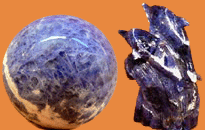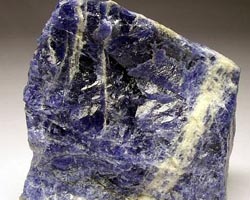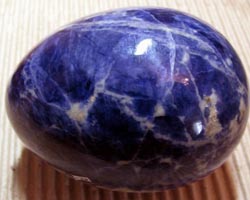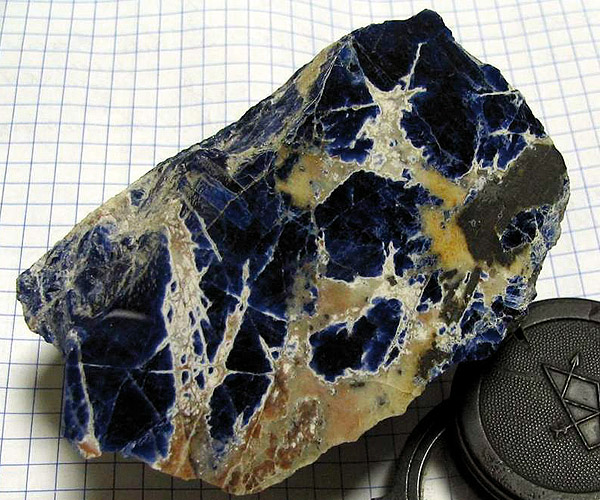SODALITE
 Characteristics of the mineral.
Characteristics of the mineral.
Very similar to lapis lazuli is the mineral sodalite (pictured right). The mineral is called sodalite, since it contains sodium (the Greek "soda" - sodium, "lithos" - stone). The mineral is also sodium aluminosilicate and is more common. Its chemical composition: sodium oxide (Na2O) 25.5%, alumina (Al2O3) 31.7%, silica (SiO2) 37.1%, chlorine (Cl) 7.3% and formula Na8Ca2 (AlSiO4) 6CI2, Or 3Na2O · Z2O3 · 6SiO2 · 2NaCl. Indeed, from a chemical point of view, sodalite is a chlorine-containing sodium aluminosilicate.
The color of the sodalite can be different. It depends on impurities and varies from blue and greenish to red. There are white, gray and colorless specimens. There are translucent sodalites. Their color varies from whitish and yellowish to greenish and blue. Often on the surface of the stone, white veins of calcite are visible. Blue opaque sodalites can be confused with azurite and lapis lazuli. Sodalites are usually found in the form of granular masses, transparent crystals are rare. Shape of crystals: rhombododecahedrons.
Sodalite is often issued for lapis lazuli (both by design and ignorance), since it is cheaper. In beads and other inexpensive adornments, slightly translucent sodalite occurs much more often than lazurite. Unlike lapis lazuli, the mineral sodalite does not contain sulfur ions and is found in the form of an array of intergrown crystals. Alomite is the trade name of blue-colored sodalite. Sodalite has a more glassy luster and can shine somewhat in comparison with lapis lazuli (lazurite does not shine at all). Lapis lazuli is often associated with pyrite (inclusions of golden color), but not sodalite. If in doubt, the mineral is sodalite or lapis lazuli, it is better to consult an independent specialist, since lapis lazuli is valued higher and often costs more than sodalite.
Magic properties of stones.
Sodalite is a good stone for meditation, because it helps a person to concentrate internally. It is believed that sodalite contributes to fighting fears and helps achieve inner harmony. Sodalite is one of the stones of the "third eye". He purifies the mind, adjusts it to inner sight and gaining intuitive knowledge. Sodalite is useful to all who want to bring their thoughts and feelings in order.





Sodalite. Blue Sodalite Mine (mine), Namibia. Photo: © А.А. Evseev.
Poisonous and radioactive dangerous stones and minerals
** - poisonous stones and minerals (mandatory check in the chemical laboratory + explicit indication of toxicity).
** - radioactive stones and minerals (mandatory check on the standard dosimeter + ban on open sales in the case of radioactivity over 24 milli / g / h + additional measures of population protection).
All rare stones are subject to mandatory inspection at the standard dosimeter for the permissible level of radiation and in the chemical laboratory for the absence of poisonous and evaporating components that are dangerous to humans and the environment.


Comments
When commenting on, remember that the content and tone of your message can hurt the feelings of real people, show respect and tolerance to your interlocutors even if you do not share their opinion, your behavior in the conditions of freedom of expression and anonymity provided by the Internet, changes Not only virtual, but also the real world. All comments are hidden from the index, spam is controlled.